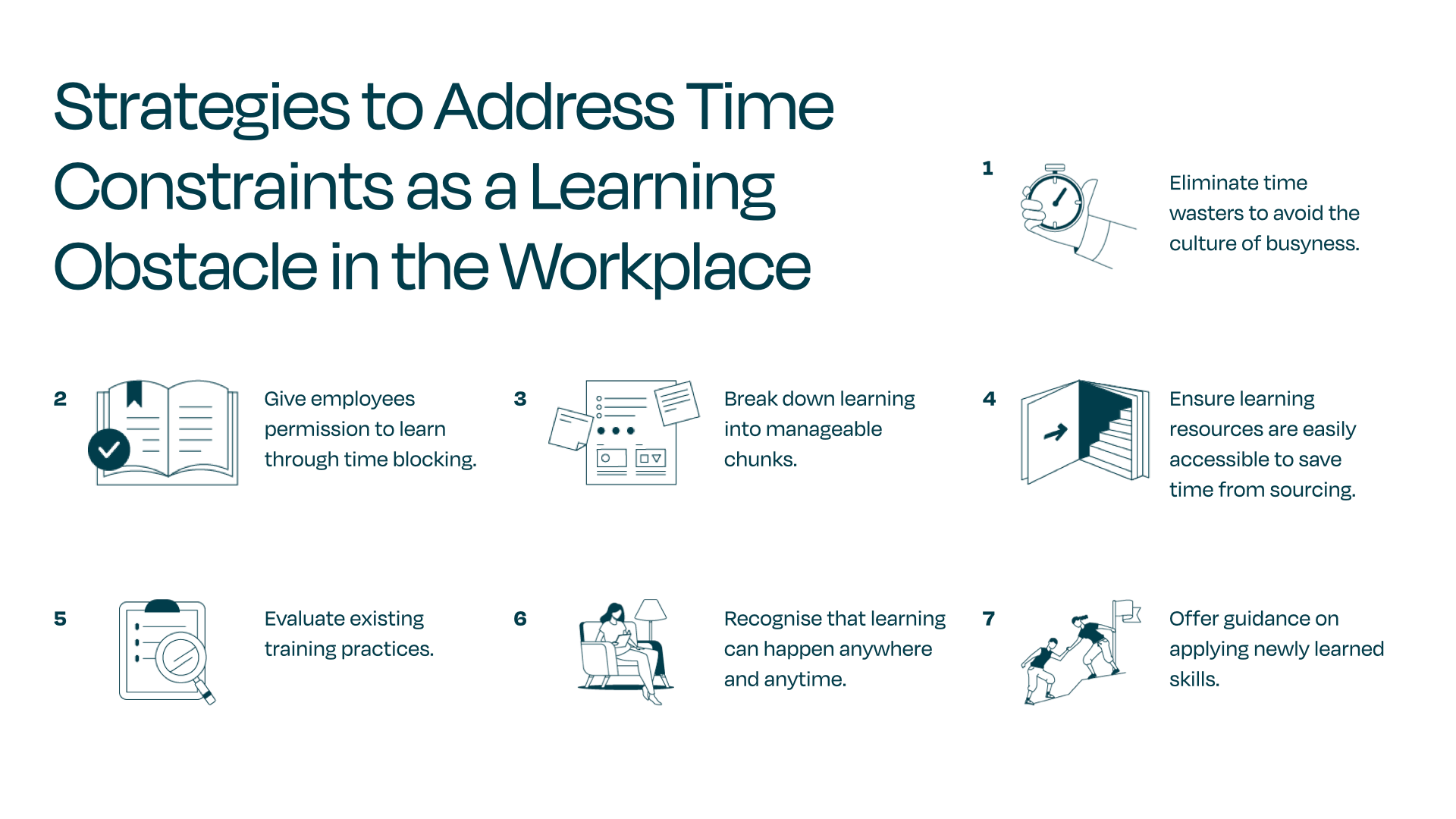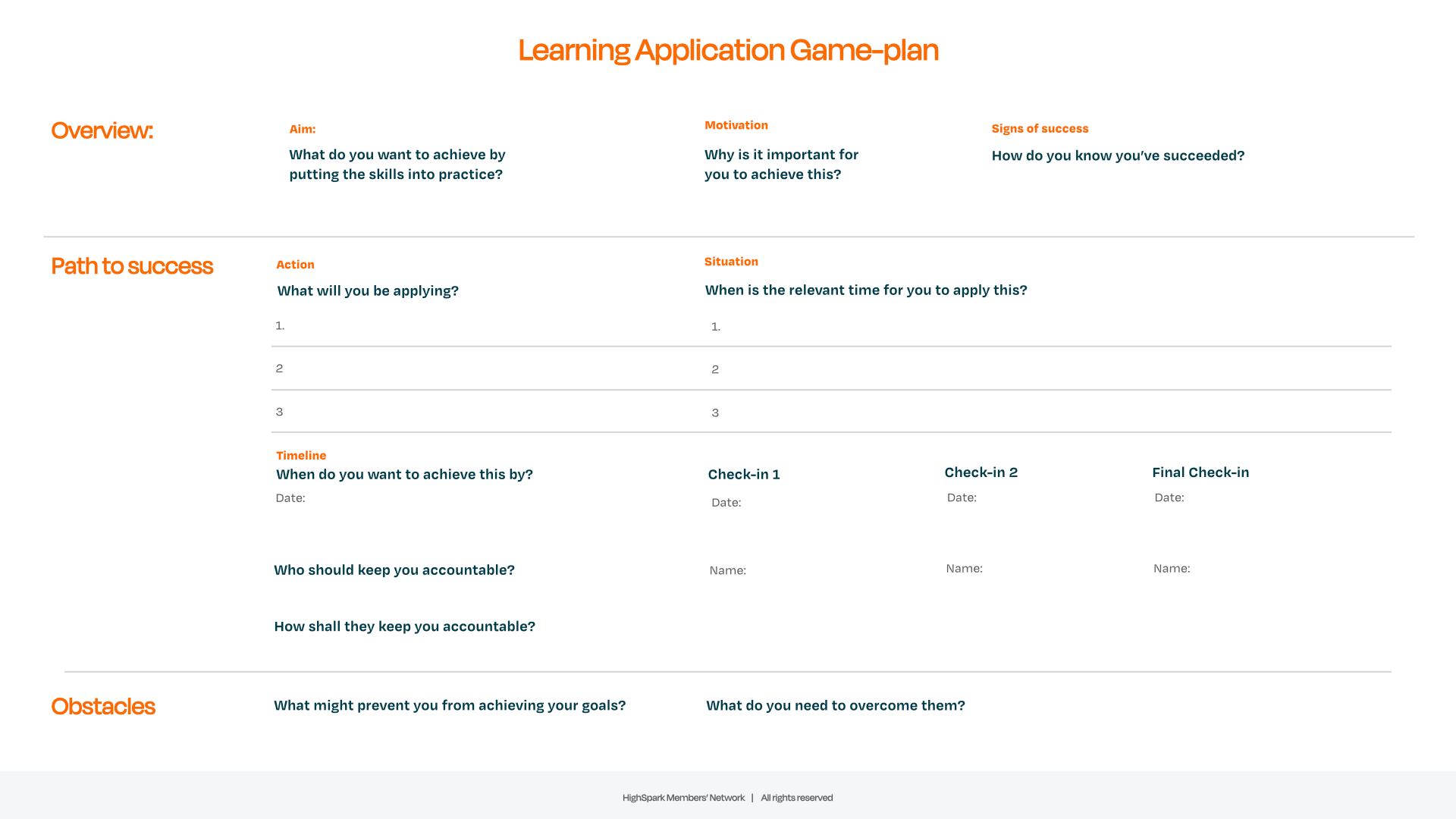Employees are busy with day-to-day operations.
Imagine a day when your calendar is bursting with back-to-back meetings, your inbox is a chaotic sea of unread emails, and your to-do list feels like an insurmountable mountain. Sounds familiar? The fast-paced nature of our work lives leaves us little breathing room, let alone time for personal growth.
At HighSpark, where we’ve conducted over 200 training sessions for 4000 learners, we meticulously sifted through consolidated feedback from 500 learners to pinpoint the primary obstacles to learning. A staggering 56% of respondents identified time as the most significant hurdle to personal growth and skill enhancement.
In a world where the pace of change is relentless, the ticking clock becomes an ever-present foe for individuals striving to thrive in the evolving work landscape. Eventually, learning resources go unnoticed, excuses to avoid learning to multiply, and fingers start pointing at the organisation for not investing in employee growth, which can ultimately lead to a talent drain.
In this segment, we will dive into practical steps organisations can take to conquer time as a learning obstacle. These steps have been carefully consolidated from various sources and real-life client experiences, saving you the hassle of searching.


#1 Eliminate time wasters to avoid the culture of busyness.
Research indicates that employees spend a significant portion of their workday dealing with irrelevant emails, contributing to decreased productivity and potential burnout
In a world obsessed with busyness, employees find it challenging to make time for learning amidst heavy workloads and competing priorities. Even during remote work, longer hours and unnecessary tasks have added to the problem.
Action 1: Managers and employees to identify time-consuming, low-value activities and foster deep work.
Organisations can combat the culture of busyness by embracing deep work, as championed by Cal Newport, author of the best-selling book Deep Work. Deep work involves dedicating sustained attention to demanding tasks, which can be hindered by shallow activities like data entry and nonessential meetings. Conducting a time audit can help identify cognitively demanding tasks, enabling managers to eliminate or replace shallow work with more efficient practices.
Action 2: HR’s role in steering away from the culture of busyness.
In pursuing a healthier work culture, HR departments take centre stage by fostering an environment where employees can thrive without being overwhelmed by an endless stream of tasks. By embracing the six recommended steps for work prioritisation outlined in AttendanceBot’s article, HR can equip employees with actionable strategies to optimise their time management, thus creating space for valuable learning opportunities.
Action 3: Leaders set the tone for a healthier work culture.
Leaders can lead by example, fostering a healthier work culture that values well-being over busyness. Emulating the practices of influential leaders like Mark Zuckerberg and Todd McKinnon, who prioritise personal time and well-being, inspires teams to follow suit and dedicate time to learning and growth.

#2 Give employees permission to learn through time blocking.
When seeking personal and professional development, employees often struggle to allocate time for learning amidst their busy lives, managing personal commitments, family responsibilities, and other non-work activities.
Recognising these challenges, managers play a crucial role in fostering a supportive learning culture by allowing employees to integrate learning into their workdays through time blocking. This simple yet powerful approach strongly conveys that the organisation values personal growth as an essential aspect of its workforce.
For instance, at HighSpark, we have successfully overcome time constraints by dedicating an hour or two every Friday for various learning purposes:

Self-learning through online courses:
Employees are encouraged to delve into subjects they are passionate about or contribute directly to their professional growth, providing autonomy for self-directed learners to chart their learning journeys.

In-house virtual webinars:
We regularly organise in-house virtual webinars, where our in-house subject matter experts share their valuable insights and knowledge. These engaging webinars are designed to make the learning process captivating and highly relevant to our team members’ roles and aspirations.
Some of our clients have also embraced a similar approach to learning. After attending external workshops or training programmes, they take the initiative to conduct specialised workshops for their team members, sharing the valuable insights they gained. This knowledge-sharing reinforces learning within their teams and fosters a culture of collaboration and continuous improvement.

Application of acquired knowledge:
For example, after attending a presentation workshop, we advocate breaking down our key learnings and scheduling dedicated practice sessions over the next few weeks, focusing on one skill at a time to master it effectively.

Reflection on learning experiences:
After attending workshops, we are encouraged to block time to discuss applying what they’ve learned and brainstorm ways to overcome potential learning obstacles.
Action 1: Implement company-wide learning time.
Set aside daily responsibilities and take some time to learn.
Managers can take action to allow employees to carve out time for growth within their work schedules. They can advocate for blocking short, dedicated periods during the workweek to explore new topics, attend webinars, participate in skill-building activities, and engage in online courses that align with their career objectives.
Offer flexible time-blocking arrangements for learning.
Recognising that every employee’s schedule may differ, managers should offer flexibility and encourage open discussions to customise time blocks according to individual needs. For instance, some employees may find value in reserving 30 minutes daily for continuous improvement activities.
Action 2: Help employees send clear signals that they are learning.
To further support learning endeavours, managers can assist in delegating workload during designated learning hours or inform colleagues of an employee’s learning schedule to minimise interruptions. Additionally, employees can set their email status to “Out of Office” during these learning sessions to focus without distractions.
Action 3: L&D to communicate time commitment and allow for focus sessions
Before attending workshops, L&D should communicate the expected time commitment to participants in advance. Employees can plan their schedules, including any necessary pre-work or preparation.
Moreover, granting permission to step out from daily operations during workshop sessions enables full engagement in the learning experience without feeling guilty or pressured. This supportive approach ensures employees can concentrate on learning, maximising the benefits of the workshop.

#3 Break down learning into manageable chunks
To make learning less overwhelming, take a step-by-step approach and set specific goals for applying new learnings instead of trying to accomplish everything at once. For example, many of our learners who attended our workshops get excited about revamping their presentation decks but often feel overwhelmed because they need more time to do so before their next presentation.
To address this, we recommend applying one concept at a time. For the upcoming presentation, focus on crafting effective headlines. Then, in the next presentation, concentrate on using analogies. Taking small steps like this ensures a more manageable and successful learning journey. To implement this approach effectively, Learning and Development (L&D) teams can take the following three steps:
Action 1: Guide learners on how to apply what they learned

After a workshop or training session, L&D teams can follow up with learners to provide clear and actionable instructions on applying what they have learned. For example, introducing a framework like the CPD cycle is excellent in guiding learners through the stages of development after learning. It typically involves planning, doing, checking, and acting to continuously improve one’s professional skills and knowledge.

Alternatively, L&D may provide employees with an action planning document to facilitate learning applications. This document could include sections for learners to identify their top learning objectives, articulate their application strategies, define the results they hope to achieve, and specify the resources and support they need to apply their learnings successfully. By prompting learners to create a detailed action plan, L&D helps ensure that the new knowledge is put into practice in a structured and effective manner that does not overwhelm the learners.
Action 2: Explore the Concept of Microlearning
Microlearning can be a powerful approach to breaking down learning into manageable chunks. For example, L&D teams can design a 30-day challenge, where learners tackle one concept or skill at a time, weekly or monthly. It’s important to note that learners may progress at different speeds, and some may complete the challenge more quickly than others.
Action 3: Begin with five minutes a day.
Remind learners that the pace of progress matters less than ensuring continuous improvement. Emphasise that learning constitutes an ongoing journey, and individuals advance at their own pace. Even short, regular learning sessions can significantly enhance your workforce’s skills. For instance, dedicating five minutes every morning to learning amounts to 25 minutes per week and 100 minutes per month!
Action 4: Gradually expand the existing five minutes a day with the 10/5 rule.
This entails allocating 10 minutes at 10 am and 5 minutes at 5 pm daily for learning. This practice aids employees in maintaining consistency and fostering a learning habit that frames the workday.
 #4 Ensure learning resources are easily accessible to save time from sourcing.
#4 Ensure learning resources are easily accessible to save time from sourcing.
Employees spend a whopping 9.5 hours per week searching for quality learning resources
When employees lack a defined roadmap for learning, it can be challenging to identify the most productive areas to invest their time and effort in.
Action: Assign courses to employees
Managers are responsible for curating and assembling learning resources. These resources cover a wide range, from online courses and comprehensive training materials to webinars, workshops, and mentorship programmes.
By allocating courses aligned with an employee’s career objectives, you’re helping employees engage with learning quickly and directly, which solves the issue of “What do I learn first?”.
With easy access to high-quality learning materials, employees are motivated to invest time and energy into enhancing their skills and knowledge.
Furthermore, they know that these learning resources align with the organisation’s vision and goals, addressing the issue of ‘what to learn next?’ This knowledge inspires them to embrace continuous improvement as an integral part of their professional journey.

#5 Evaluate existing training practices.
In the digital age, people are bombarded with information from various sources, leading to shorter attention spans. It becomes challenging for employees to devote prolonged periods to focused learning. To make learning experiences worth employees’ time, organisations need to evaluate their existing training practices.
By understanding employees’ preferred ways of learning, the desired frequency and duration of training, and the relevance of the training content, organisations can personalise the learning experience and make it more valuable for each individual.

Action: L&D to roll out surveys to identify employees’ learning preferences.
To implement personalised learning, organisations should roll out surveys to capture employees’ learning preferences and desired areas of development. You’ll be surprised to find out that traditional training approaches that require extended periods away from work or lengthy courses may not align well with employees’ busy schedules, making it harder for them to commit to learning. Perhaps they prefer something bite-sized like a lunch and learn crash course and one that allows them to learn on the go.
These insights can then be translated into tangible actions, such as revamping training programmes, curating tailored learning paths, and offering a range of resources that cater to individual needs. By continuously gathering feedback and adapting the learning experience, organisations foster a culture of growth and empower employees to thrive through personalised learning journeys.

#6 Recognise that learning can happen anywhere and anytime.
This section explores the 70-20-10 rule, which emphasises that formal learning should be kept to a minimum, allowing for significant time outside formal learning activities such as engaging in social learning or integrating learning into day-to-day operations.

Let’s visualise how the 70-20-10 rule can be implemented in a presentation training context:
10%: Formal / Informal Self-Directed Learning
Allocate a small portion of your time to attend a full-day workshop or enrol in an online course specifically tailored to enhance your presentation skills. This structured learning will equip you with foundational knowledge and essential techniques. For those with busy schedules, you can also explore self-directed options like subscribing to relevant newsletters or listening to podcasts during your daily commute to stay updated and informed.
20%: Social Learning
Actively seek manager, peer, or mentor feedback by delivering real-life presentations. You can also record your presentations and analyse them for improvement. Alternatively, you can explore creating group chats after attending a formal training event or joining public speaking or Toastmasters clubs to keep knowledge sharing alive.
70%: Experiential Learning
Apply your presentation skills to everyday conversations and interactions. Whether it’s team meetings, client discussions, or informal gatherings, treat each opportunity as a chance to practice and hone your skills.
By following the 70-20-10 rule, organisations and individuals can leverage the natural way people learn, seamlessly integrating learning into the daily workflow. It empowers individuals to learn continually without overwhelming them with additional learning commitments. Remember, the percentages are not rigid but serve as a reminder of where learning predominantly occurs.
Action 1: L&D to build learning interventions following the 70-20-10
To maximise learning outcomes and foster a culture of continuous development, L&D teams should adopt the 70-20-10 model when designing learning interventions so organisations can seamlessly integrate skill development into daily operations without overwhelming employees’ time. Check out this article for a comprehensive understanding of the 70-20-10 concept and practical implementation strategies.
While incorporating the 70-20-10 model into your organisation’s learning and development strategy is a powerful way to enhance employee development, it’s crucial to acknowledge that not all employees are at the same stage when it comes to becoming self-directed learners. Some individuals may thrive in a self-directed learning environment, while others might still require guidance and support in determining the most suitable learning format for their needs and the most effective way to learn.
Understanding the various stages of a self-directed learning model, such as the one proposed by Gerald Grow, can be immensely beneficial for L&D teams. Read more about the Four Stages of Self-Directed Learning here.
Action 2: Employees to embrace informal learning opportunities
Identify regular practice opportunities in your daily work routine, such as team meetings, client interactions, or any other relevant scenarios where you can practice the newly acquired skills regularly. Embrace these chances to refine your abilities, making the learning process integral to your professional growth.

#7 Offer guidance on applying newly learned skills.
To help employees apply their newly acquired skills, offer close guidance and support during the application phase. Some learners may struggle with overthinking when applying what they’ve learned, and time pressure adds to the challenge. In such cases, seeking assistance from managers, coaches, or trainers can be beneficial in speeding up the application process.

The fastest learner wins.
By implementing these practical solutions and strategies, you can overcome the lack of learning time and prioritise continuous professional growth and development. Remember, you can adapt and thrive in a rapidly changing world by investing in your learning journey.
Up Next: Learning isn’t perceived as valuable.
You know that feeling when you’re about to hit the gym, but suddenly, other activities seem way more enticing? Well, the same goes for learning. Employees who don’t see the value in learning will conveniently use “not enough time” as an excuse to learn or apply what they learned. Ultimately, it all boils down to their intrinsic or extrinsic motivation.
While we have extensively explored the culture of busyness, designing effective learning interventions, and making learning convenient in this article, we’ll now delve into another underlying factor that greatly influences learners’ behaviour in using time as an excuse not to learn – motivation. Head over to the next article to explore more.



